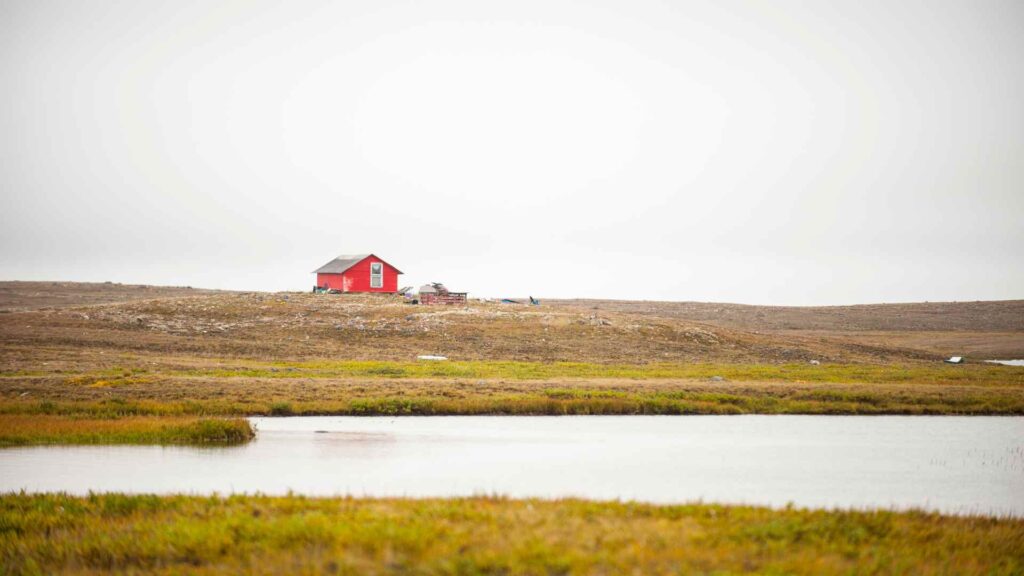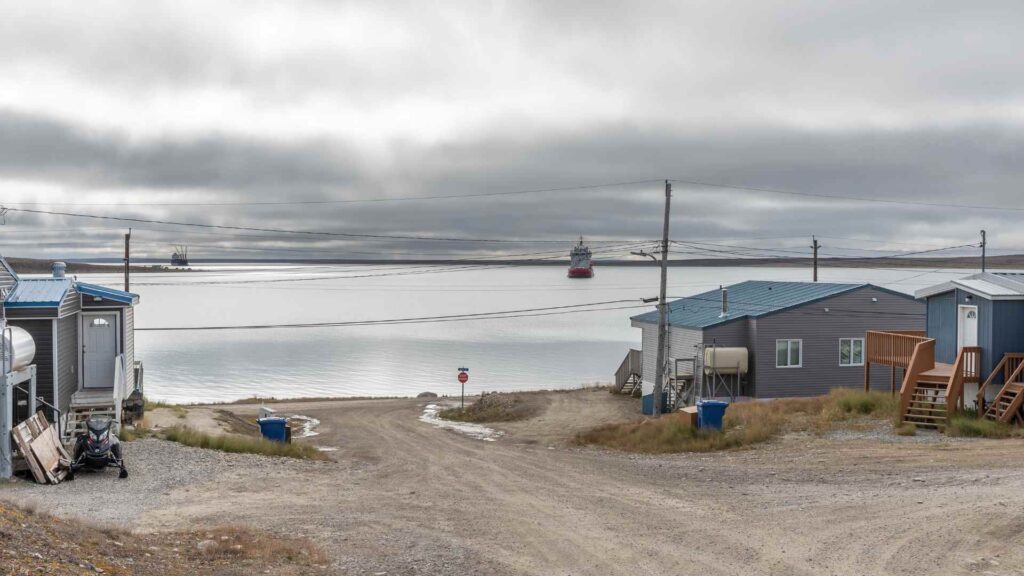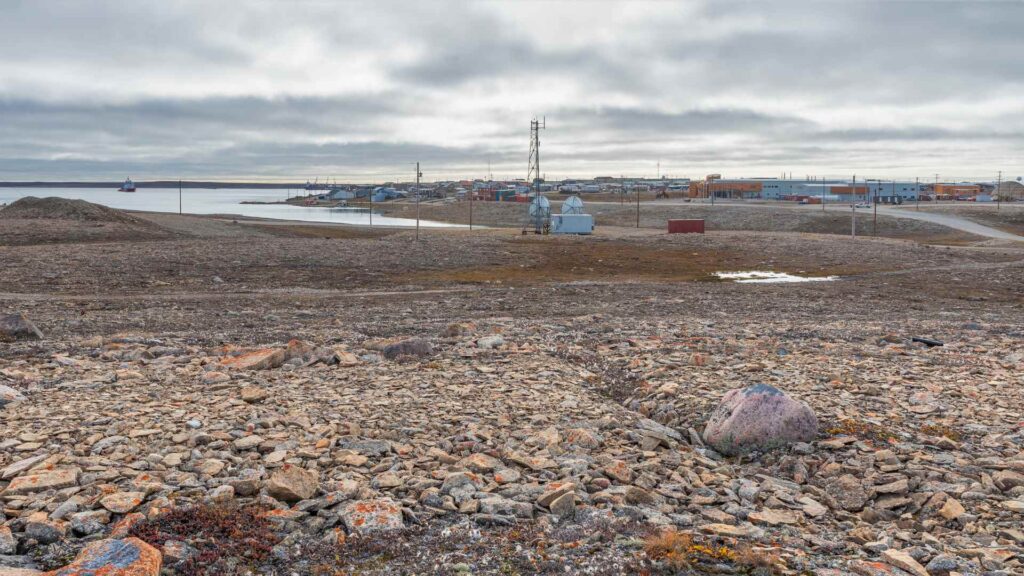Set sail for an incredible journey to Cambridge Bay, a very remote Arctic community bursting with natural beauty and captivating cultural heritage.
This hidden gem, located on Victoria Island in Canada’s Nunavut territory, offers a one-of-a-kind experience with dramatic vistas, truly friendly locals, and a glimpse into genuine Arctic life.
Location & Overview
Cambridge Bay, known locally as Iqaluktuuttiaq, sits on the southeastern coast of Victoria Island in Nunavut, Canada.
This modest yet vibrant hamlet is a hub for Inuit culture and a gateway to the fabled Northwest Passage.
When cruise ships arrive here, they bring adventurers eager to explore the unspoiled Arctic landscape.

Where Exactly Is Cambridge Bay?
- Positioned along the Arctic Ocean, Cambridge Bay offers a unique vantage point for seeing sea ice, wide tundra landscapes, and breathtaking sunsets that transform the sky into a palette of pinks and oranges.
- It’s a key transportation and administrative center in the Kitikmeot Region of Nunavut. That means it’s well-equipped with essential services—surprising for such a remote destination.
A Brief History
- The area has been inhabited by the Inuit for centuries, drawn here by an abundance of fish and caribou.
- With the arrival of European explorers, Cambridge Bay evolved into a contact point along the Northwest Passage.
- The name Iqaluktuuttiaq translates to “good fishing place,” reflecting the longstanding tradition of harvesting Arctic char in the nearby waterways.
Why Cambridge Bay Is Special
- Cultural Significance: The hamlet is known for its thriving Inuit community, local artistry, and warm hospitality.
- Natural Beauty: Polar bears, muskoxen, and snowy owls roam freely in the surrounding tundra, offering an unparalleled glimpse into Arctic wildlife.
- Remote Charm: Though it might seem off the beaten path, its remoteness is part of the appeal. You’ll be able to feel the crisp Arctic air and see pristine landscapes without the usual crowds.
What to Expect From the Landscape
- Tundra Terrain: Rolling hills of tundra replace the tall forests you might be used to in southern Canada. Low-growing shrubs, wildflowers, and lichens add pops of color in the short summer season.
- Coastal Marvels: Its location on the Dease Strait invites incredible water views. If you’re lucky, you might spot marine mammals surfacing for air during a crisp Arctic morning.
Cambridge Bay stands out as a blend of rugged beauty and cultural depth, making it a perfect port of call for adventurous cruisers looking to immerse themselves in the high Arctic’s splendor.

Cruise Arrival & Practical Logistics
Arriving in Cambridge Bay by cruise ship is an adventure in itself.
As you sail the chilly waters of the Arctic Ocean, you’ll witness ice floes, dramatic coastlines, and perhaps even whales breaching in the distance.
Once you dock at the port, a world of discovery awaits just beyond the gangway.
Port Facilities
- Tenders and Small Docks: Many Arctic cruises use tenders to shuttle passengers ashore because large cruise ships often anchor just offshore. The local dock facilities are modest yet functional, ensuring a safe and efficient transfer.
- Visitor Centre: Near the dock, you may find an information booth or small visitor center where you can pick up brochures, get maps, and talk with local guides.
- Rest Areas and Essentials: While facilities might be limited compared to bigger ports, you’ll likely have access to basic necessities like restrooms, Wi-Fi hotspots, and a spot to grab a quick drink or snack.
Transportation Around Cambridge Bay
- Walking: The hamlet is compact, making it easy to explore on foot. Stroll the gravel roads and take in the Arctic breeze as you head from one site to another.
- Community Shuttles: Occasionally, local businesses or tour companies offer shuttle services between key points of interest.
- Taxis: There are usually a few local taxis available, but it’s wise to coordinate rides ahead of time, especially if you have specific sights in mind.
Entry Requirements and Permissions
- Identification: You’ll need a valid passport if you’re arriving from outside Canada. Make sure to check visa requirements beforehand if you’re an international traveler.
- Customs and Immigration: Your cruise line usually handles most customs clearances, but be prepared to present necessary documents when going ashore.
Currency and Banking
- Canadian Dollar: The official currency in Nunavut is the Canadian dollar (CAD). Small vendors may only accept cash, so keep some CAD on hand.
- Credit Cards: Larger shops and hotels might accept major credit cards, but service can be inconsistent.
- ATMs: There is typically one or two ATMs in the community, but they can run out of cash, especially during busy cruise visits.
Health & Medical Services
- Local Health Centre: Cambridge Bay has a small health facility that can address minor ailments. However, resources are limited.
- Travel Insurance: Ensure you have comprehensive travel insurance that covers emergency evacuation, given the remote Arctic setting.
In short, arriving at Cambridge Bay feels like stepping into another world.
Though facilities might be simpler than in major ports, you’ll be greeted by local experts ready to guide you through an Arctic experience that’s as authentic as it is extraordinary.
Embrace the logistics, plan ahead, and you’ll be all set for a remarkable visit.

Top Attractions & Must-See Sights
Cambridge Bay might look unassuming at first glance, but it’s brimming with fascinating spots that showcase Arctic life, history, and natural wonders.
Whether you’re keen on cultural immersion or scenic vistas, there’s something here to pique everyone’s interest.
1. The Hamlet Itself
- Community Buildings: Wander by the community center, local co-op, and small businesses to get a feel for daily life.
- Art & Craft Shops: Look for Inuit carvings, wall hangings, and other handmade works that tell the story of the people who inhabit this land.
- Street Murals: Keep an eye out for artistic expressions on walls and buildings, offering a modern take on traditional Inuit themes.
2. Canadian High Arctic Research Station (CHARS)
- Innovative Research: This state-of-the-art facility focuses on climate change and Arctic sustainability. Visitors can sometimes take guided tours to learn about ongoing scientific projects.
- Educational Exhibits: Display boards and interactive showcases provide insights into Arctic ecosystems and the challenges faced by communities here.
- Visitor-Friendly: Check if any public events or open houses are happening. It’s a great way to see how science and local knowledge come together.
3. Old Stone Church (St. George’s Anglican Church)
- Historic Landmark: Dating back several decades, this small stone church is a cherished symbol of the community’s past.
- Architectural Curiosity: Built with local materials and featuring simple but meaningful design elements, it stands as a testament to the adaptability of Arctic residents.
4. Inuinnaqtun Language Learning
- Cultural Immersion: Several local initiatives offer crash courses or language demonstrations. Hearing Inuinnaqtun spoken in everyday contexts deepens your appreciation for the community’s heritage.
- Interactive Sessions: You might find community-led workshops that teach basic phrases or share folklore in the native tongue.
5. Local Beaches
- Rocky Shorelines: While not your typical sandy retreat, the shoreline near Cambridge Bay offers serene vistas of the Arctic Ocean.
- Sea Glass Hunting: Keep an eye out for smooth pieces of glass along the shore—little souvenirs washed and polished by icy waters.
- Bird Watching: Migratory birds flock here in certain seasons, so bring binoculars if you’re keen on spotting rare species.
Why These Sights Matter
- Cultural Preservation: Each attraction offers a glimpse into how traditions adapt in a changing world.
- Environmental Education: Understanding local initiatives, like CHARS, underscores the importance of protecting fragile Arctic ecosystems.
- Community Connection: Interacting with residents and observing daily life is perhaps the most authentic way to appreciate the region.
Make the most of your time by prioritizing the sights that resonate with your interests—be it science, religion, history, or simply soaking in the Arctic scenery.
Whichever path you choose, you’ll come away with a richer perspective on what makes Cambridge Bay such a compelling port of call.
Cultural Encounters & Local Etiquette
One of the most rewarding aspects of visiting Cambridge Bay is the chance to engage with Inuit culture. From traditional games to modern arts, locals here are proud to share their heritage.
However, showing respect and understanding local customs will make your cultural encounters more meaningful and authentic.
Inuit Traditions You Might Experience
- Drum Dancing: This rhythmic art form often tells stories passed down through generations. If you’re lucky enough to watch a performance, remember that it’s more than entertainment—it’s a cultural expression that resonates with the community’s history.
- Throat Singing: Performed by two singers, this mesmerizing vocal interplay imitates natural sounds such as wind and wildlife.
- Storytelling Sessions: Elders may share narratives about the land and animals that have been part of Inuit oral traditions for centuries.
Respectful Engagement
- Ask Before You Snap: Many people appreciate visitors who want to document their experiences, but it’s polite to ask permission before photographing individuals or private spaces.
- Don’t Rush Conversations: In many Inuit communities, conversations involve pauses for reflection. Patience and active listening show genuine respect.
- Offer Thanks: Simple phrases of gratitude or interest in the local language, such as learning a few words in Inuinnaqtun, can go a long way.
Participating in Local Events
- Community Feasts: Sometimes visitors are invited to join communal meals featuring local staples like Arctic char and caribou.
- Craft Workshops: These can range from traditional sewing to carving demonstrations. Roll up your sleeves and try your hand at a new skill.
- Cultural Festivals: Depending on the season, you might witness annual gatherings or local events celebrating the community’s connection to the land and the sea.
How to Be an Ally
- Show Genuine Interest: People respond positively when they see you’re eager to learn, not just observe.
- Mind Your Questions: Inquire respectfully about traditions without prying into deeply personal matters or making assumptions.
- Support Local Businesses: Buying handcrafted goods or locally sourced products helps sustain the community’s economy and traditions.
Cultural Sensitivity Tips
- Dress Appropriately: The weather can be harsh, but also consider modest clothing when attending community events.
- Avoid Wasting Food: In a land where resources can be scarce and expensive, wasting food is especially frowned upon.
- Gift Giving: A small token of appreciation, like sharing a snack from your home country or a simple keepsake, can foster warmth and friendship.
Embracing local etiquette enriches your trip and deepens your connection with the people you meet.
Cambridge Bay’s cultural heritage is a treasure, and by engaging with an open heart, you’ll create memories that resonate far beyond your time in this Arctic haven.
Outdoor Adventures & Wildlife
If you crave wide-open spaces and the thrill of encountering Arctic animals, Cambridge Bay will exceed your expectations.
From tundra hikes to wildlife-spotting expeditions, there’s an entire world of outdoor adventure waiting right off the cruise port.
Tundra Trekking
- Guided Tours: Local guides can lead you through the rolling tundra, pointing out unique flora like Arctic cotton and purple saxifrage.
- Self-Guided Walks: If you prefer solo exploration, stick to well-marked paths and bring a map or GPS. Weather changes rapidly here, so always tell someone where you’re going.
- Safety Gear: The terrain can be uneven. Wear sturdy boots and dress in layers to adapt to sudden temperature shifts.
Wildlife Encounters
- Muskoxen: These shaggy, prehistoric-looking creatures roam the tundra in small herds. Admire them from a distance to avoid startling them.
- Arctic Char: Fish for this local staple if you have the opportunity. Some excursions provide fishing gear and a chance to catch your dinner.
- Birdlife: From the majestic snowy owl to flocks of migratory geese, avian life abounds. Keep binoculars handy to spot rarer species like gyrfalcons.
Water-Based Excursions
- Kayaking: Imagine gliding through the still waters of the Arctic Ocean with ice floes occasionally drifting by. Some tour operators offer guided kayak trips in calmer weather.
- Zodiac Cruises: Hop on an inflatable boat to explore the coastline and look for seals or even narwhals, if you’re extremely lucky.
- Polar Plunge: Feeling brave? Some cruise lines or local outfitters coordinate a quick dip in the frigid Arctic waters—an adrenaline rush like no other.
Responsible Travel in a Fragile Ecosystem
- Leave No Trace: Pack out everything you pack in. The tundra is delicate and takes a long time to recover from damage.
- Respect Wildlife: Keep safe distances. Avoid chasing or feeding animals, as it can harm them and endanger you.
- Follow Local Guidelines: Listen to your guide’s advice. They know the land and can steer you toward the best experiences while maintaining ecological balance.
Don’t Forget the Camera
- Golden Lighting: The Arctic light can be magical, especially during sunrise and sunset. Keep your camera ready for spontaneous moments.
- Weather Protection: Cold and moisture can affect electronics, so have a waterproof or protective cover for your gear.
Venturing into the Arctic wilderness around Cambridge Bay is both humbling and exhilarating. Every step on the tundra, every glimpse of a muskox, and every paddle stroke on the icy ocean brings you closer to understanding the raw, captivating essence of the North.
Best Time to Visit & Climate
Timing your trip to Cambridge Bay can make all the difference, especially given the Arctic’s dramatic seasonal shifts.
From endless summer daylight to frigid winter nights illuminated by auroras, each period offers its own distinct charms—and challenges.
Summer (June to August)
- Extended Daylight: Near the summer solstice, nights are barely dark. This phenomenon, known as the Midnight Sun, allows for longer sightseeing days.
- Milder Temperatures: Expect highs ranging from 5°C to 15°C (41°F to 59°F). Still chilly by many standards, but comfortable compared to the rest of the year.
- Wildflowers and Wildlife: Tundra blossoms paint the landscape in vibrant colors, and animals emerge to forage in the warmer weather.
- Peak Tourism: Late July to August is popular for cruise ships. Book excursions early as availability may be limited.
Autumn (September to October)
- Changing Colors: Tundra foliage transforms into shades of gold and red, creating picturesque scenery.
- Cooling Temperatures: Frosty mornings become the norm, and you might see the first hints of snow by late October.
- Quieter Season: Fewer tourists mean more tranquil exploration, though some tours and facilities may start to wind down.
Winter (November to April)
- Extreme Cold: Temperatures can plummet to -40°C/F, so proper gear is essential. This season is not typical for cruise arrivals, but some expedition ships might visit the Arctic ice.
- Polar Night: Expect very limited daylight, especially around December’s winter solstice.
- Northern Lights: On clear nights, you might be treated to dancing auroras—an unforgettable experience.
Spring (May)
- Transition Period: Daylight starts to lengthen again, and temperatures slowly climb above freezing.
- Melting Ice: Rivers and shorelines gradually thaw, attracting migratory birds.
- Shoulder Season: Fewer tourists and a chance to see nature waking up, but services might still be limited.
Clothing & Packing Tips
- Layer Up: Even in summer, you’ll want layers—base layers, a fleece or sweater, and a water-resistant jacket.
- Waterproof Footwear: Snow, slush, or wet tundra can soak your feet quickly if you’re not prepared.
- Sun Protection: The sun’s reflection on ice and water can be surprisingly strong. Bring sunglasses and sunscreen.
When to Come
- For Wildlife: Summer is prime time. Warmer temps attract both marine and land animals near the coastal areas.
- For Aurora Viewing: Plan a late winter or early spring visit (though typical cruise schedules may not align with these months).
- For Cultural Events: Check local calendars. Summer often hosts community gatherings, while winter events focus on indoor celebrations.
Overall, the best time to visit Cambridge Bay by cruise is during the late summer window when ships frequent the Northwest Passage.
You’ll find relatively mild weather, abundant wildlife, and a vibrant community scene waiting to welcome you to the Arctic frontier.
Tasting Arctic Flavors
Sampling local cuisine is a highlight of any journey, and Cambridge Bay provides a window into the culinary traditions of the Inuit.
While modern foods have made their way north, there’s still a strong emphasis on local staples that have sustained communities here for generations.
Traditional Foods
- Arctic Char: This flavorful fish is often smoked, grilled, or pan-fried. It’s rich in Omega-3s and has a delicate, buttery taste.
- Caribou: Prepared in a variety of ways—dried, stewed, or roasted—caribou is a staple protein that has been part of Inuit diets for centuries.
- Muktuk: A traditional dish made from whale skin and blubber. Its chewy texture and unique flavor might be an acquired taste for newcomers, but it’s a cultural mainstay.
Modern Twists on Tradition
- Fusion Dishes: Some home cooks and local cafés put a contemporary spin on classic Inuit foods by adding spices or incorporating them into Western-style recipes, such as Arctic char chowder or caribou burgers.
- Bakery Treats: Look for local bakeries that serve bannock (a simple bread) alongside coffee or tea.
- Seafood Variety: In addition to char, you might find cod, Arctic shrimp, or clams, depending on the season’s catch.
Where to Eat
- Community Events: Keep an eye out for feasts or communal dinners. These gatherings often showcase local delicacies you may not find on a regular menu.
- Small Cafés and Diners: Cambridge Bay has a few eateries that serve a mix of Canadian and local cuisine. The menu might be limited, but the welcoming atmosphere more than makes up for it.
- Onboard Your Cruise: Some expedition cruises feature locally sourced ingredients to give passengers a taste of regional flavors.
Culinary Etiquette
- Gratitude and Sharing: Food is integral to Inuit hospitality. If you’re offered a meal or snack, accept graciously, and don’t hesitate to share what you have.
- Try a Little of Everything: Even if some dishes seem unfamiliar, tasting them is a sign of respect and open-mindedness.
- Mind Your Portions: In remote communities, food security is critical. Take only what you’ll finish to avoid waste.
Shopping for Local Ingredients
- Co-op Stores: These community-based supermarkets might stock local fish or meat, although supplies can be sporadic.
- Fishing Excursions: Catch your own Arctic char on a guided trip and prepare it fresh for an unforgettable meal.
Embarking on a culinary journey in Cambridge Bay offers flavors you won’t find anywhere else.
Whether you’re sharing a meal in a local home, sampling Arctic char at a café, or trying your hand at catching your dinner, you’ll discover that food here is more than sustenance—it’s a tangible link to the Arctic way of life.
Insider Tips & Safety
Traveling to the Arctic may feel daunting at first, but with the right information, your visit to Cambridge Bay will be smooth and unforgettable.
From what to pack to how to handle emergencies, these insider tips ensure you’re prepared for anything the Arctic throws your way.
Plan Ahead
- Limited Supplies: Stock up on essential items—medications, personal care products, and spare batteries—before you arrive. Local shops have limited stock, and deliveries can be delayed due to weather.
- Book Tours Early: Arctic cruises often schedule guided excursions, but spots fill quickly. If you have a must-do activity (like fishing or a cultural workshop), reserve your place as soon as you can.
Stay Warm and Comfortable
- Dress in Layers: A base layer, insulating middle, and waterproof outer shell let you adjust to unpredictable Arctic conditions.
- Invest in Good Footwear: Warm, waterproof boots are a lifesaver. Cold, wet feet can end an outdoor adventure quickly.
- Mind the Wind Chill: Even if the sun is shining, Arctic winds can create a biting chill. Always bring a scarf or neck gaiter.
Connectivity and Communication
- Internet Access: Cell service might be spotty, and Wi-Fi can be slow. However, the main community areas usually have some level of connectivity.
- Emergency Contacts: Keep a written list of crucial phone numbers (like your cruise line’s local agent and the health center) in case your phone battery dies.
Environmental Responsibility
- Follow Wildlife Guidelines: Never feed or approach wild animals. Respect posted signs and local advice to minimize human-wildlife conflict.
- Tread Lightly: Arctic landscapes are fragile. Stick to established trails and practice “pack in, pack out” ethics.
- Support Local Conservation: Consider contributing to local environmental or cultural preservation initiatives if you have the chance.
Safety Precautions
- Know the Signs of Hypothermia: Shivering, confusion, and exhaustion can signal that you’re too cold. Get indoors and warm up immediately if you experience these symptoms.
- Bear Safety: While polar bears aren’t common in the immediate vicinity of Cambridge Bay, it’s wise to remain alert if you venture far from town. Local guides carry deterrents for safety.
- Medical Emergencies: The local health center can handle minor issues, but anything major may require a medical evacuation. Double-check that your insurance covers air ambulance services.
Engage with Locals
- Ask for Recommendations: Locals often know the best spots for wildlife viewing, fishing, or taking in scenic sunsets.
- Respect Privacy: Not everyone welcomes unannounced visits or questions. Approach people politely and respect their personal space.
A successful trip to Cambridge Bay hinges on balancing preparedness with curiosity. Pack thoughtfully, follow local guidelines, and keep an open mind.
By doing so, you’ll not only have a safe journey—you’ll also forge deeper connections with the Arctic and the people who call it home.


